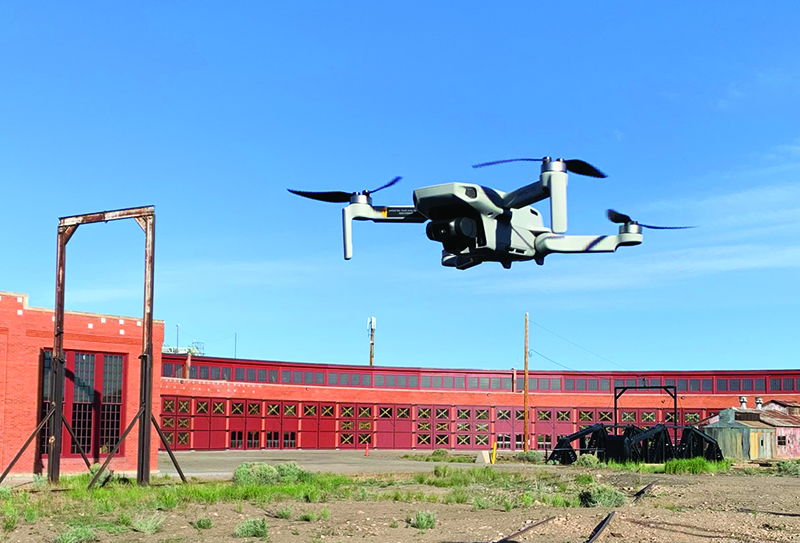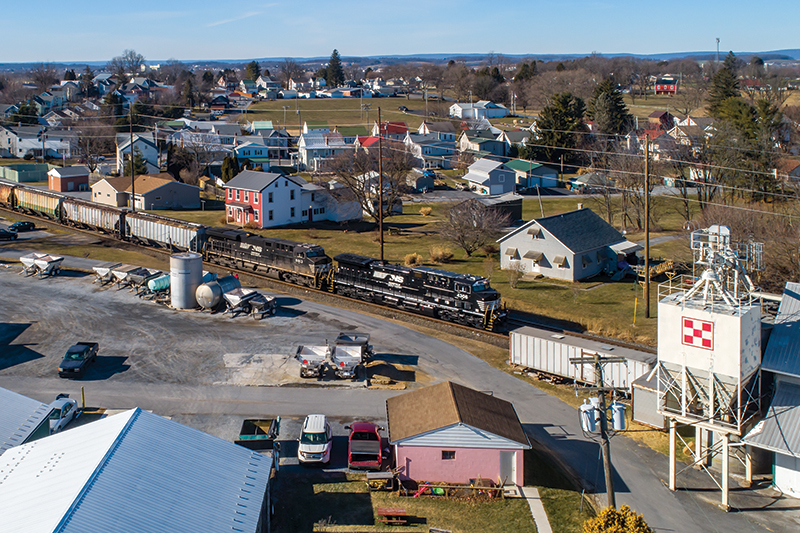 ˜Recreational drones are one of the fastest-growing segments of the transportation sector and, according to the Federal Aviation Administration, there were more than 1.7 million registered drones in the U.S. at the end of 2020. That doesn’t count unregistered drones, those under 250 grams. The use of drones has also skyrocketed in the field of railroad photography. While it’s also almost impossible to put an exact number on how many railfans are now flying, it’s nearly impossible to open up a railroad magazine or go on Flickr or Facebook and not see an aerial photo.
˜Recreational drones are one of the fastest-growing segments of the transportation sector and, according to the Federal Aviation Administration, there were more than 1.7 million registered drones in the U.S. at the end of 2020. That doesn’t count unregistered drones, those under 250 grams. The use of drones has also skyrocketed in the field of railroad photography. While it’s also almost impossible to put an exact number on how many railfans are now flying, it’s nearly impossible to open up a railroad magazine or go on Flickr or Facebook and not see an aerial photo.
With more “birds” in the air, the FAA has spent the last few years trying to figure out how it can make the sky safer for both drone pilots and other airspace users. In December 2020, the agency released the most sweeping set of drone regulations yet, including one that will require you to either upgrade your current drone or possibly buy a new one.
Remote ID
While the FAA released several new rules — including those that would let certified pilots fly at night or over people and vehicles without FAA permission — the thing that will likely impact railroad photographers the most is the new Remote ID requirements. Starting in 2023, it will be illegal to fly a drone that weighs more than 250 grams (including popular models like the DJI Mavic Air and DJI Phantom) unless it comes with or has been outfitted with broadcasting equipment that lets others see where it is and who is flying it. Presently, when you register your drone with the FAA, you’re supposed to put the registration number on the side of the drone. But unless you have a really good set of binoculars, it’s pretty hard to read that number when it’s hovering some 200 feet in the air. With Remote ID, once the drone takes off and until it lands, it will need to broadcast via Wifi or Bluetooth its registration number; its location, altitude, and velocity; the time; and the location of the drone’s controller (aka you, the pilot).
The largest recreational drone manufacturer, DJI (which as of early 2020 had more than 70 percent of the market), has long been in support of Remote ID, and back in 2017 proposed what it called an “electronic identification framework” for small drones that would allow authorities to identify drone owners when necessary. Shortly after the FAA released its regulations regarding Remote ID, DJI announced that it would work to implement it into its drones.
“DJI has long supported the FAA’s Remote ID initiative because it will enhance drone accountability, safety, and security,” a company spokesperson told DroneLife.com. “The FAA’s deliberative process of reviewing over 50,000 public comments has resulted in a rule that will serve the whole industry, as operators move on to more complex drone operations that save lives and benefit society. We are reviewing the final rule to understand how DJI can take steps toward complying with the FAA’s upcoming requirements.”
Since then, DJI hasn’t said much about the new rules (the company did not respond to multiple requests for comment from Railfan & Railroad), but it’s safe to say it is probably busy trying to figure out how to implement Remote ID into its drones. According to the FAA, older drones will not be grandfathered in and therefore will have to have an agency-approved broadcasting device added to the drone. Is DJI working on such a device for owners of drones like the Mavic Air or Phantom? Or will it be as simple as a software upgrade? After all, the drone can already broadcast a lot of information to your phone; what’s stopping it from broadcasting to other devices? It’s hard to say as of this writing in early 2021, but what is certain is that drone users will want to keep an eye out for future developments.

The Mavic Mini doesn’t fit in your pocket, but it comes pretty close.
Smaller Drones
A lot has changed in the drone world since we last visited the topic in this column a few years ago. But perhaps the biggest development has been in size. Back in 2016, when Editor Steve Barry first wrote about the topic in this space (See “Up, Up and Away: A First Look at Drone Photography” in the July 2016 issue), the DJI Phantom was probably the top choice for railroad photographers. At the time, the DJI Phantom 2 Vision+ (the drone Barry was using) weighed in at a hefty 1,160 grams, sported a battery that could keep you flying for about 25 minutes, and had a 14-megapixel camera.
Five years later, DJI’s Mavic series of drones is arguably among the most popular on the market and in the railfan community. The Mavic Air 2, for example, weighs half as much as the Phantom 2 Vision+ (coming in at 570 grams), has a flight time of about 34 minutes (in optimum conditions), and has a 12-megapixel camera with the ability to stitch together 48-megapixel images.
In 2019, DJI shrunk things down even more with the introduction of the Mavic Mini, a 249-gram drone that sells for about $400, making it an attractive entry-level drone for those wanting to test the waters of drone photography. The Mini has a 12-megapixel camera and about a 30-minute flight time. The size of the drone is particularly notable — at 249 grams, it does not have to be registered with the FAA if you are flying recreationally, nor would you need to upgrade to comply with the new Remote ID rules (if you’re doing commercial work, you still need to be Part 107 certified, according to the FAA).
Some sacrifices had to be made, however, to keep the drone under the 250-gram limit, most notably that the Mavic Mini does not have forward or rear obstacle sensors. Some would argue that’s a small price to pay for a drone that easily fits inside a camera bag, which for the railfan on the go might be the most attractive part about it. The Mavic Mini does not shoot RAW images — much to the dismay of some photographers — however, its successor, the DJI Mini 2 that was released in 2020, does shoot RAW with the same 12-megapixel camera. Even without the RAW capabilities, the Mavic Mini can produce solid results that you will be happy with. The way I look at it, the sensor on the Mavic Mini is still bigger than the sensor that was in my DSLR a decade ago.
One thing is clear from the last few years of drone development — things are only going to get better for railfans looking to take to the sky. While the drones like the Mavic Mini and Mini 2 are still in their infancy, companies like DJI are trying to put more and more into a smaller package.
When the new rules do go into effect (manufacturers have 18 months from publication in the Federal Register to comply and users have 30 months to comply), it’s likely that what’s available on the market will be vastly improved over today’s offerings. Will the wait be worth it? Simply put, when it comes to drone technology, we can only go up from here. — Justin Franz



